Back at Eurobike this past summer there was a lonely tent outside next to the bike trial area. Under that tent was a single Wahoo KICKR, a flat-screen TV, a laptop, and a bicycle. Oh, and an Oculus Rift VR headset.
You know…just the standard issue things you’d find next to any bike trainer setup.
I gave the Zwift VR setup a quick whirl at the time, though never ended up publishing anything on it. In part because in my sleep deprived state I somehow thought a 48-second video clip and one photo of the TV would be sufficient for a post (you can see that unlisted clip here, in case you’re curious).
But this time around at CES – I was ready! Or at least, half-awake. So let’s dive into it. Do note that this is totally pre-beta, and totally not released yet. So like most of CES, it’s a preview of what might be to come.
(If you want to skip to a video overview I put together, it’s down below)
Zwift in VR:
So what is VR? Well VR (Virtual Reality) enables you to immerse yourself in an experience. Typically that’s computer generated worlds (like Zwift), though not 100% of the time. How does that differ from 360°? Well, VR is 360 (when done right), but 360 isn’t necessarily VR.
VR usually implies some level of control within that world, like playing a video game where you move around. Whereas with 360, you’re seeing the world in 360 and can change the viewpoint, but usually won’t have control of your direction/place in that world. For example, if you watch any of my 360° videos here (a whole playlist full!), you can control the view, but I’m controlling the direction of travel (such as on a bike or on skis). Said differently: You’re just along for the ride.
Oh – and not to throw too many things at you, but all of these are different than augmented reality. That’s typically overlaying data onto glasses (or similar) that are actually showing you more detail about what’s in front of you. So if you imagined your sunglasses overlaid the names and power data of Tour de France riders floating above their heads as they rode past you, while you stood on the side of the road on Alp d’Huez. That’s augmenting your reality, by giving you more cool stuff. But again, different than VR.
So as I was saying, with VR, you also need some sort of additional hardware to put you in that world. Typically that’s a headset. In the case of Zwift, they’re leveraging the Oculus Rift headset, which is one of the most popular ones out there.
Next is that Zwift VR requires a PC at this time – and a pretty powerful one at that. Though on the bright side you don’t need a big screen TV, since you won’t see that once you put on the headset.
And of course you’ll want a bike and a trainer. As sitting at your dinner table in your cycling kit and headset going nowhere will get kind of boring. In this case, it’s a Wahoo KICKR2, but that’s just a function of them being housed in the Wahoo booth at CES. You can use any trainer you’d like, and any bike you like (even a unicycle if you can find a way to attach it to your trainer).
Finally, you’ll plop on that headset to get all VR’d up! The headset will allow you to change your viewpoint. Now normally in Zwift you’d change views into one of the canned options available. But in Zwift VR you can turn your head to change your view, just like you would in real-life.
For example, if I look downwards (Froome Style) at the stem, it’ll show me the stem:
Note that the laptop is showing the two lenses within the headset. Kinda a preview mode. You, as the rider of course, see one cohesive picture within the headset. But their preview for the peanut gallery watching in the booth doesn’t show that today.
I can look anywhere I’d like, even behind me. This is pretty cool if you have a large group ride around you, to be able to look around and see the positioning of those in your group.
I put together a bit of a short video explaining all this, along with a bit more demo’ing how it works and feels in real life:

All in all it works pretty well, especially on an electronically controlled trainer because the resistance is changing with the terrain, making it more realistic. Of course, for the ultimate in realism they or someone else would want to develop a way to change the pitch on the bike and shake it accordingly. I also saw that at Eurobike too, and was originally slated for the same Zwift VR post that never happened. Here’s what that looks like (first 48 seconds are Zwift, last half is crazy system from HeroVR):

Note that in that demo, it was more targeted at events and such, and not really consumers. It also wasn’t running Zwift. But I will point out it was pretty damn cool. Had it been in Zwift, in a mountain bike mode allowing me to go wherever I like – that would have been the pinnacle of awesome. Now I’m just waiting for Titanium Geek or Lama to put together instructions on how to build a DIY Zwift variant.
Yes, I’m here. I’m still waiting.
Is it done yet?
So is this the future?
Let’s be clear: This is the future of indoor cycling.
But let’s also be clear: It isn’t the future anytime soon.
Why’s that? Well in part because of the hardware limitations. For example – at $599 a pop, an Oculus headset isn’t cheap. And said headset simply isn’t designed for a long and intense sweat-fest. You’ll kill them after a ride or two. Not to mention it’ll get hot and stuffy inside the headset.
Of course, there are cheap cardboard-style systems (and other plastic ones) that you can put your phone in and achieve a similar VR effect. But in my experience, there’s an inverse relationship between the quality of these headsets and whether you get motion sick using it. The more expensive, the less sickness. The cheaper, the more sickness.
I’ve actually tried a bunch of cycling VR simulations over the years. And without question this was the cleanest setup I’ve ridden. And the only one I didn’t want to exit the bike immediately (I’m lucky in that I’ve almost never gotten motion sickness, even in the roughest of seas, flights, or situations).
But again – the biggest challenge is just cost. Zwift has actually had this capability since almost the very beginning. In fact, they sent over a photo to me, showing a very early meeting where this existed – all when the company was only a couple of people:
John Mayfield, Zwift’s founder, notes that this is really about showing where the company could go:
“Our aim with demonstrating Zwift VR was to show what is possible. If you actually get in a group ride in VR mode it’s is unbelievable – the feeling of riding with other actual humans is overwhelming.”
He goes on to talk about some of the challenges with hardware:
“I actually added VR mode to the software back in 2013 so it’s been in there all along, but disabled. In fact I gave Eric Min a demo of it the day we first met at my house. The problem is that even 3 years later VR headsets are not common devices, and the gaming computers needed to power them are equally scarce – at least among cycling enthusiasts.
Lower price point and more exercise friendly VR headsets are on the horizon. The PSVR is a good example at $399, and it has a headset that isn’t pressed up against your face. Seems like it ticks off both of the checkboxes, aside from probably being for PlayStation 4 only. Phones are also getting more powerful, although I see it taking a couple more years before they are really an option for full detail MMO style 3D applications in VR. The A10 in the iPhone 7 looks to be a real powerhouse….one step closer.”
So might there be something that could sneak out down the road?
“I wouldn’t rule out a quiet release of it as an Easter-egg type feature so that the Zwifters who own a headset (HTC Vive or Oculus Rift) could try it, but I can’t commit to it right now. We are still small (literally 3 programmers plus me make the Zwift “game”) and we need to stay focused on delivering the best non-VR experience first.”
All of which makes sense. Zwift is developing at an incredible pace, and gathering an even more incredible following. One only need to log in any given night this winter season to see that. So redirecting resources elsewhere probably isn’t ideal for 99.99% of users. At the same time, being on the leading edge of tech is all about being on that edge. It’s about pushing the limits of what’s possible, and making people re-evaluate their previous positions.
In my case, until this point my experiences with cycling in VR have all made me want to find the nearest rest stop. But Zwift VR was different – it was the first time it was actually interesting and engaging.
Now we just need the hardware to catch-up.
With that – thanks for reading!
—
Catch all the CES 2017 posts here in one handy to read page. And fear not – there’s still tons more to come from (the massive backlog of) CES!
FOUND THIS POST USEFUL? SUPPORT THE SITE!
Hopefully, you found this post useful. The website is really a labor of love, so please consider becoming a DC RAINMAKER Supporter. This gets you an ad-free experience, and access to our (mostly) bi-monthly behind-the-scenes video series of “Shed Talkin’”.
Support DCRainMaker - Shop on Amazon
Otherwise, perhaps consider using the below link if shopping on Amazon. As an Amazon Associate, I earn from qualifying purchases. It doesn’t cost you anything extra, but your purchases help support this website a lot. It could simply be buying toilet paper, or this pizza oven we use and love.

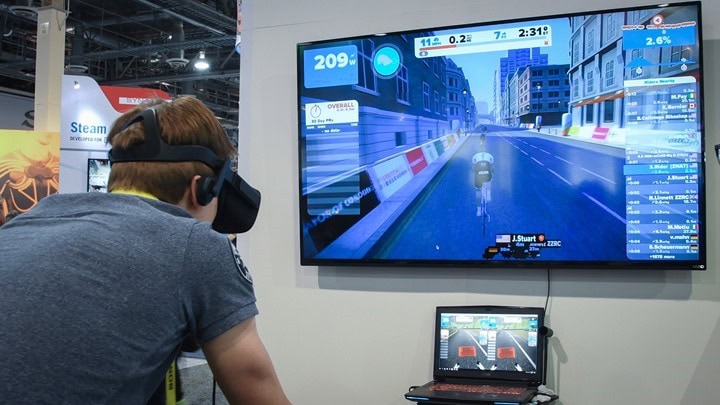
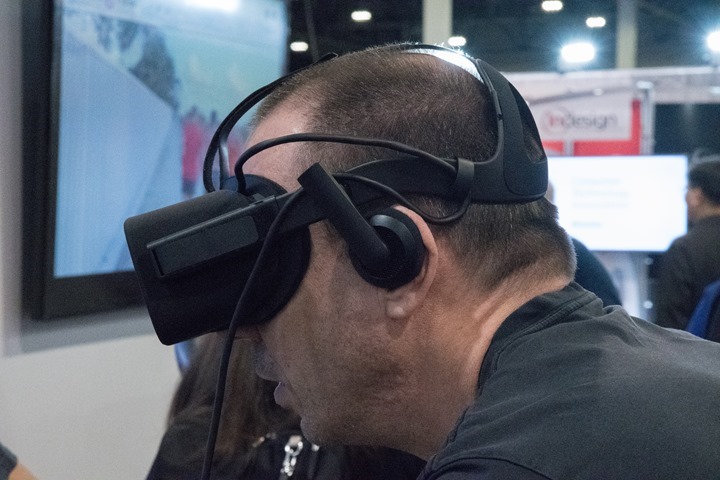
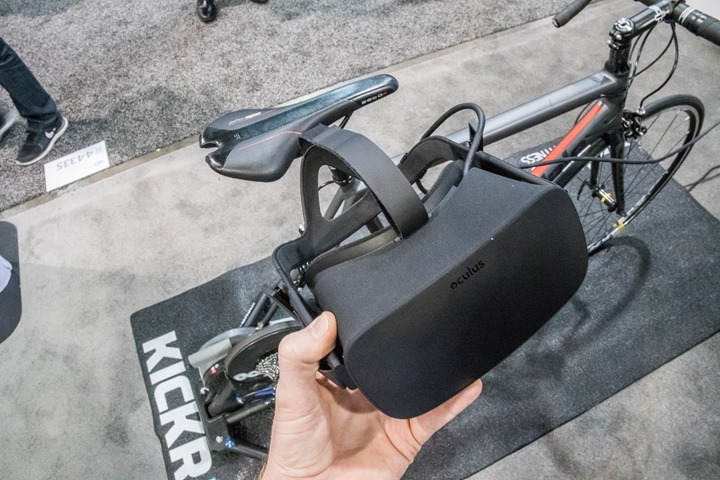
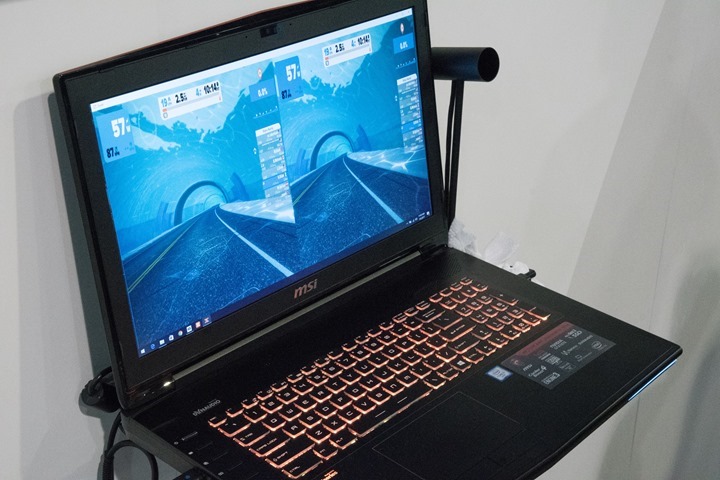
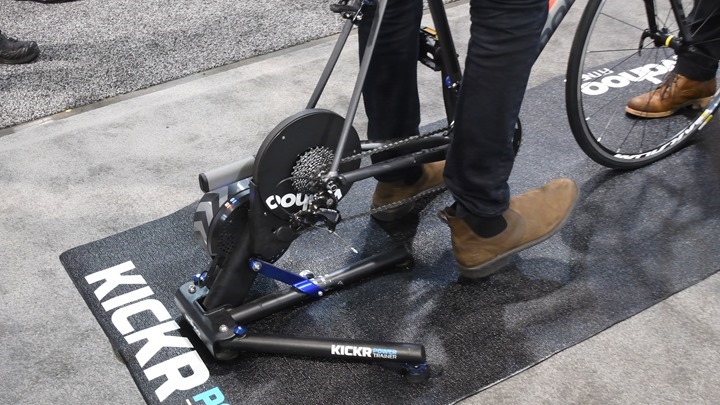
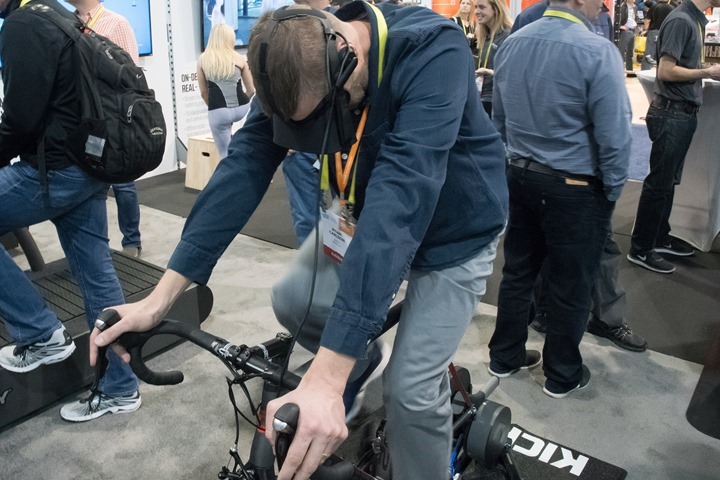
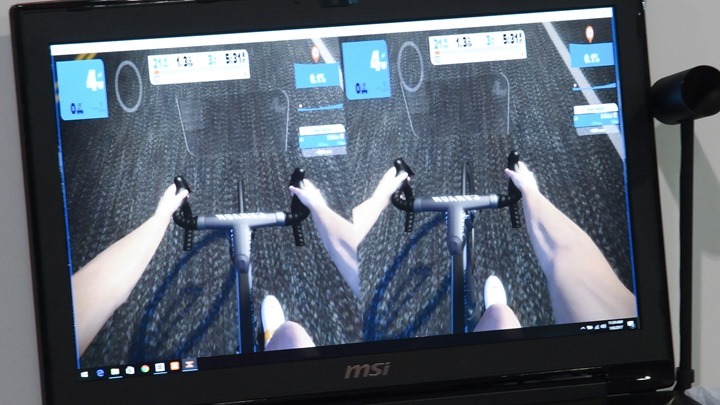
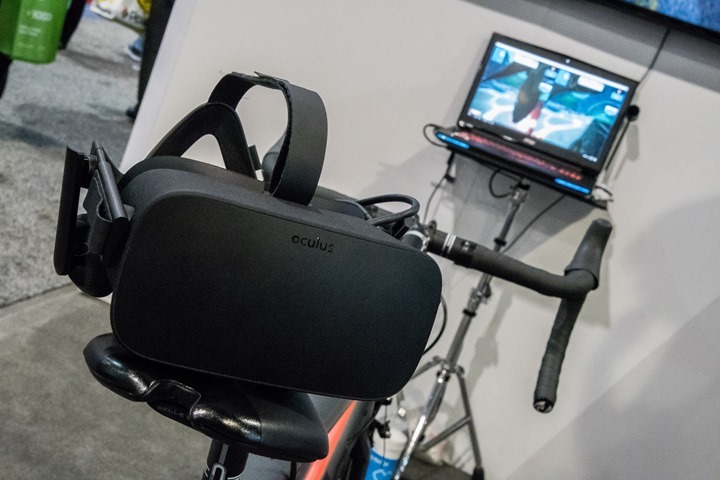
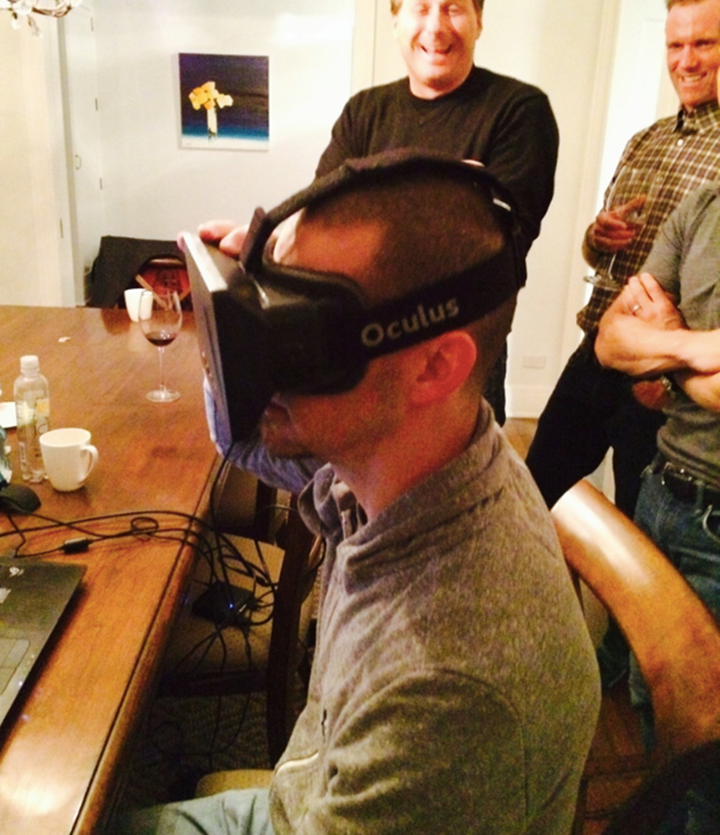





















The sceptic in me feels that that headset will get very sweaty very fast…
Probably not an unfair assessment. I think the weight of the headset combined with your normal position on a racing bike is also not ideal, as the weight is in front of you neck muscles. This could really fly when headsets become lighter and lighter, more like regular glasses (ski goggles probably). For now bleeding edge, going on cutting edge and moving on mainstraim (hopefully) :)
you’ll need your normal fan then a tiny fan that’s part of the headset. ;)
I tried this too at CES – I did my tempo at 290 for 5m – very sweaty. Also hard to manage getting your hands on the bars.
I would assume this will work better on a platform like MSFT Halolens eventually.
This is indeed a future look at what’s coming in 2 yeas!
I had the chance to try this a couple of weeks ago at a Zwift event. It’s really crazy — a very immersive experience. In Zwift normally, I feel like the limitation is the visuals — you see a limited view of the world, along with your basement wall, and we’re all used to this perspective from watching TV or playing video games. It doesn’t seem unusual.
But with Zwift VR, I felt like the limitation became the fact that you’re riding on a fixed, inflexible trainer, and this becomes amplified once you take away the visual limitation. For example, as you approach a curve, you more naturally turn your head to look down the road (and you get the right visual feedback), and you *really* want to lean your body, which is not a great idea on a trainer. When this comes out, be ready for reports of people falling off their trainers — I can already see the YouTube compilation videos in my head.
Combined with the price and sweat-factor issues Ray brings up (plus, I found the VR system kind of heavy to have on your face while riding), I think the trainer itself will probably need some evolution as well.
Your thoughts re: the evolution of the turbo trainer are spot on, but undoubtedly something that could be developed to receive input from the Zwift software (or other software) and react accordingly (lean bike, tilt up or down to simulate ascents/descents), etc…).
Likely an expensive system… but I’d bet there are cyclists out there willing to pay.
Yeah, if you check out the second half of the second video – that type of setup would be cool.
And I think it could be sold as an after-market item, and I suspect there’s room in the market for a Tacx/Wahoo sized company to make one (after all, that setup was using a Wahoo SNAP). Zwift and others would undoubtedly support it quickly.
Realryder makes an indoor trainer that leans. Couple them together with the inputs from Zwift VR & it might just work. Hopefully that development finishes about the same time as the lightweight, ventilated VR goggles are created.
As somebody that rides Zwift on rollers, I can 100% assure you that VR won’t be used in my pain cave!! On the flip side, I do have an Oculus headset for gaming, and it’s pretty darn cool.
you just need to get better at rollers.
I don’t see cost being a major blocker – we’re talking about a target market of people with bikes costing a few thousands, and a home trainer costing anywhere from 200 to 1,800 USD.
Shelling out 600 USD for VR equipment that could be used for training but also a ton of other activities should not be that much of an issue. The sweat thing however – clearly an issue for now, but with the VR market expanding someone wil ltackle that challenge sooner rather than later.
it’s note the $600 for the headset, it’s the $1000 – $2000 you need to spend on the PC that will be powerful enough to run this.
Call me naive, but I do think VR will join 3D and curved TV sets for consumers in quite some time.
Not to say there isn´t use for VR but, for consumers, I think people will get bored after a while.
I’d be more interested in augmented reality (like you mention, adding labels and metrics on top of the real world) than this. It’s not like this would improve your endurance metrics.
Sweat would ruin that headset in 30 minutes.
I destroyed my beloved Bose QC15 noise cancelling headphones over a single sweaty 2 hour trainer ride this weekend! The ear cups now need to be replaced. Clearly equipment needs to be made for exercise, but if there is a market for it I’m pretty sure an “Oculus Sport+” sweat proof and lightweight version isn’t too far off. This might be one of the better applications for VR tech
Interesting, my QC15’s have gone the distance. Aside from being a gazillion years old, I wear them occasionally on the trainer and haven’t killed them yet. I try and wipe them down afterwards. Last winter I did replace one foam ear pad though (cheap on Amazon). Note, not the electronics, just the ear pad.
Get Urbanwear Hellas sweatproof headphones…problem solved
link to urbanears.com
Until ventilation is even considered this is a non-starter tech demo for me. VR is nice and certainly cool but it can’t possibly add much other than “because I can” for now.
I had the chance to demo it during their north america tour and it was mind blowing cool. I felt like a neanderthal who was just shown fire. My sense is that it would be great for longer rides when the technology advances enough that lighter headsets with some form of active cooling can be developed.
Now this I could see completely changing the home trainer experience to making it something more “REAL.” – or certainly far more interesting than the normal “looking at a laptop screen for 60min” experience.
I spend a fair amount of time on the turbo during the winter, and even during the other months as I find it’s just more time efficient and easier to fit in structured training sessions around a busy schedule. Make a well-ventilated, sweat-proof VR Headset and couple it with a great VR Zwift environment, and I’ll happily shell out my hard-earned money for it.
Did they talk about Zwift for android at all?
Usually I’m pretty skeptical about VR stuff, but this actually seems like a real good application of it once the technology catches up. Usually the whole immersion benefit of VR is ruined by the fact you have to use a controller to move around in a game, but here you’d be interacting with the simulated world in exactly the same way you would in the real world (tactile controls, movement based on body movement not artificial buttons, etc.) so you could really get into it.
Getting a lighter, properly sweatproof headset is critical, but you’d also need some way to read the steering and brake position (so you could freely explore the virtual world and not just ride on rails) plus a trainer like Kinetic’s rock and roll but with controlled resistance on the tilting mechanism. We’re a little off from that now, but the building blocks are all there – put it all together and you’d have one heck of a system :)
A couple of summers ago at Spin London I had a go on Activetainment’s Occulus Rift ebove link to instagram.com
Despite the motion sickness it was very cool, have you seen/tried that one to see it compares to this setup?
Puzzled when you said that a Zwift ride could ‘kill’ a £700 headset, I use mine very regularly on very demanding games like Elite Dangerous and alls well for now. Could you explain what you mean by killing the headset and why is Zwift so demanding on the headset? Cheers.
Sweat. A Zwift session involves a lot of sweat. And sweat kills electronics that are not sealed and designed to handle it.
I don’t know about this one. I mean VR should offer experiences you can not experience otherwise. Why recreate the experience of cycling then? Riding famous routes? Maybe, but just shooting some zombies get`s you all sweaty under the htc VIVE. So you would need some kind of ventilation.
Plus there is nausea. Driving in project cars made me kind of sick. Sure cycling is a lot slower but should still be fast enough to cause a serious disconnection between body and brain for not moving.
ok this pic is definitely how Chris Froome sees the Tour, can’t believe I’m the first to mention
Can’t be Froom, there is no power meter ….
You’re not exactly the first to mention it. The line directly above the pic in the article:
“For example, if I look downwards (Froome Style) at the stem, it’ll show me the stem”
Darn, I was sooooo excited
I’ll take the wheel mover before I take the headset. being able to actually have my bike at the grade I am training on without having to pile phonebooks on boxes is invaluable. The goggle stuff would make me feel like the gimp in Pulp Fiction (and yes I know his eyes are open and it’s his mouth zippered shut).
Hmmm. Is this really the future of indoor training? Maybe about the time we close colleges, replaced by download all human knowledge through a neural implant. I do think that it represents a bifurcation of indoor training expectations. Pre-Zwift, folks on the trainer in the pain cave wanted fitness/weight loss. Now, Zwift has added a social / group ride / race component. For the former community, VR is an irrelevant expense to be avoided. For the latter community, VR might offer some real value, especially if the headset/exercise issues are resolved. Now, those interested in the social component may also be interested in the training component and wish to fiddle with only one rig. Fair enough. But there are likely some that will find little/no value in VR for bike training for a very long time.
Given that I’ve been playing non-exercised based games in my Oculus Rift and had the lenses fog up from sweat I can’t see this working when you are actually working out…
As Ray says the headset is hot so if you’re exerting yourself on a bike I think this would get pretty uncomfortable pretty quickly – and I certainly wouldn’t want to ever use the headset again afterwards!
Zwift most add a First Person view, and thats it…
*Flies away
Did today a another long zwift session, cannot imagine doing most of my zwift sessions with this VR thing on my face. I sweat a lot, even with a fan right in front of me. Another thing would worry me – a weird feeling or even motion sickness (as a kid I had big problems in vehicles so I might be susceptible), because you immerse just your sight, no g force, just a stiff bike. Might be different with a special trainer, but then it would mean putting quite a lot of money in a good setup – VR goggles, a decent PC, a special trainer, that’s a lot of money, in my case lots of money put into something that is quite a seasonal. Probably not for me.
Thanks for this post. I am just getting to Zwift and find it a completely different experience compared to the typical indoor ride (i.e., watching a movie or music). I love the social and visual aspects. These elements make indoors rides more interesting and competitive. While nothing can replace a real ride, I am hopeful that as time moves forward the technology will enable enhancement for the indoor rider. I live in the northeast United States and our ride time is really limited. This is especially true if one doesn’t care for cold weather. I’m curious about the future of indoor riding. I noticed the MB VR segment in your post. Do you see anything on the horizon that can mimic road feedback and changes in elevation? Any insight is appreciated. Thanks!
Hi Ray
Curious if you think Apple’s announcement today that it would up the maximum allotted size for apps on the Apple TV from 200MB to 4GB will speed up than Apple TV version of zwift?. My understanding is that developers now have 20 times the space they had before to include more graphical elements, which will be especially useful for game designers zwift?
Thanks
To all those arguing “well, they’ll surely solve the ‘sweat problem'” I’m curious what you see as a practical resolution? I’m not seeing it. Water cooling?
Simply waterproof it. Plenty of heads up displays in sport that are waterproof. Waterproofing this isn’t that difficult for sweat.
So, I hooked up my Samsung as per this guide: link to vrbites.com so I ran run Steam VR and Occulus SDK apps. How do I make ZWift Display in VR?
For those who need virtual Power with real Data i have dev some FREE Hard-/ Software:
link to instructables.com
Ride on.
Hey DC,
I am an avid cyclist from Minnesota living in the horrible biking conditions of Michigan. I have always found your posts insightful, thorough and helpful in navigating my decisions and purchases in the wonderful world of training equipment. This was reviewed some time ago (and no comments have been made recently) and I was wondering if there is any follow up to your original review?
In particular…
1. Have you found that the technology still requires a computer or laptop to function properly?
2. Are these still outrageously expensive or are there reasonable alternatives (phone mounts and the sort) that are competitive with stylistic/functional/comfort drawbacks that high-end models provide.
3. Any other information for an interested user would be great!
Thanks for keeping it up for all these years!
Well… this one died in silence, so it seems? Ray, is there any news? Where did the VR option go to? What happened?
Nothing I’ve seen or heard unfortunately.
> Now we just need the hardware to catch-up.
This story is starting to look a little better with the Quest 2. I would love to try it with Zwift.